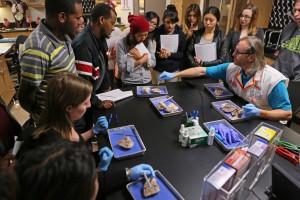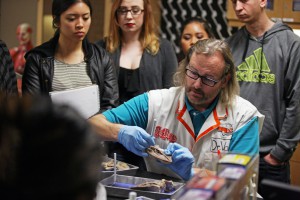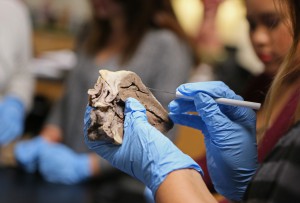Doc Vegas is getting excited.
“So, we’re about a minute away from my favorite image in all of biology,” he tells his class, and you can still hear a little bit of his native Georgia twang. “I can’t wait. It’s going to be cool.”
He’s got almost 20 students in his biology 224 lab on CSN’s Cheyenne campus. That’s Human Anatomy and Physiology II. It’s a complicated, difficult course. Hard to get lost, hard to keep up. Even for these students, who have all had more than one biology course already. Most are going to be nurses or other health care workers, though, so keeping up is important. Whether it’s the routine stuff or the really cool stuff, like what’s coming up.
Today, the first lab of the semester, they started out with a quiz. Now they’re watching a video of a frog being dissected.
Which is when the cool part comes.
“Watch this,” says Doc Vegas, whose real name is Vance Whaley. He’s been teaching at the College of Southern Nevada for four years now. You can tell he loves his job.
The guy in the video removes the heart from the frog completely. It’s dangling there on a fishing hook.
And. It. Is. Still. Beating.
“Come on,” says the prof. “That’s absolutely awesome, right?”
It is, but the really awesome part of today’s lab is still coming up.
Whaley points the students to one of the tables, where he’s laid out several sheep hearts. They’re gray and meaty looking. Kind of gross. Slimy. He tells them they’re going to be dissecting the hearts today, though he’s careful to say they don’t actually have to wield the knife. They can just watch if they want to.
But they really should dive in.
“There’s not many times in life when you can grab a heart in one hand and a scalpel in the other,” he says.
He shows them the parts they’ve studied in the books and on the plastic models. The difference between the left and right sides, the atrium, the interventricular septum, the three different parts that end with -cardium.
“Errybody with me?” he says. That Georgia twang again. He repeats this again and again, every time he’s explaining something that might be hard to get. The truth is, he knows it can all be hard to get.
He knows because Whaley is still a student, too, just a few months away — he hopes — from completing his doctorate.
He’s already a doctor; he’s been a chiropractor for 12 years. But he wants more. He wants to be an educator.
You can tell that when you watch him in class.
He’s up there now, done with the sheep hearts for today. They’re moving on to electrocardiograms.
But first, a pause for another cool moment in biology, though smaller than the heart-beating-by-itself moment.
Turns out, the little ear pieces in a stethoscope shouldn’t just go straight into your ear. You should twist them a little before you put them in, make sure they’re angled toward your eyeballs so the sound goes straight into the ear canal. So says Doc Vegas.
“Twenty percent of nurses don’t know that,” he tells the class. And he’s excited about it, this cool tip he’s passed along to his class.
That’s how you can tell he loves what he’s doing.
He’s excited about the frog heart thing, sure. Who wouldn’t be? But Whaley knows that the workaday world isn’t full of those kind of moments. It’s full of the routine stuff, like how to use a stethoscope properly.



